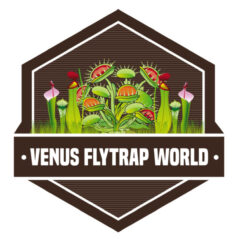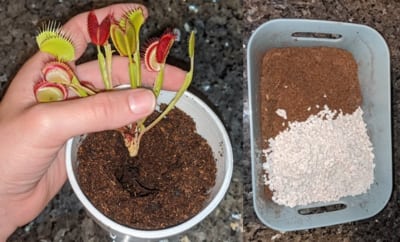Venus flytraps require a very specific environment to survive. You must choose the soil type and composition carefully to keep the plant healthy. In this article, I will share the best soil options for Venus flytraps and information about the potting procedure.
Venus flytraps must be planted in nutrient-free, mineral-free soil with good drainage. A combination of sphagnum moss or peat moss with silica sand or perlite are excellent potting mediums for carnivorous plants. The moss retains moisture and the silica sand and perlite prevent soil compression, provide draining and aeration.
This article will guide you through the process of mixing up the right ingredients for Venus flytrap soil. Remember, incorrect components can poison your plants with nutrients. Also, you can buy safe carnivorous plant soil online.
Are you looking for information on carnivorous plant care? If yes, you are in luck! Read this Venus flytrap care guide. In this guide I share all I know on how to grow healthy Venus flytraps.
Venus Flytrap Soil
Venus flytraps cannot process minerals or nutrients from the soil. Therefore, you must employ nutrient-free mineral-free components. Also, since Venus flytrap requires a consistently humid environment, it is beneficial to choose a potting medium with proper drainage and aeration.
You can buy carnivorous plant soil or make it yourself. Generally, you must mix two ingredients: one type of moss and a draining agent. For example, you can employ peat moss and perlite or long-fibered sphagnum moss and silica sand.
Here are a few recipes to make a carnivorous plant soil mix for your Venus flytrap:
- 4:1 or 2:1 ratio of peat moss and perlite
- 4:1 or 2:1 ratio of peat moss and silica sand
- 4:1 or 2:1 ratio of sphagnum moss and perlite
- 4:1 or 2:1 ratio of sphagnum moss and silica sand
If you struggle to find the soil ingredients in a brick-and-mortar store, consider buying them online. Here are some links to the soil brands I usually employ for all my carnivorous plants:
- Pure peat moss for carnivorous plants: https://amzn.to/3vTqirs (you might find a cheaper option on local gardening stores, make sure you buy PURE peat)
- Pure perlite: https://amzn.to/3ppckLF
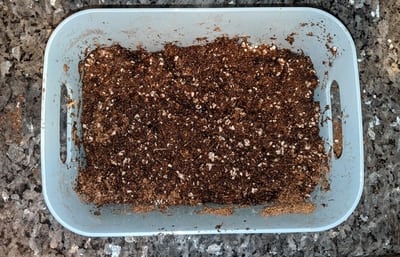
You do not have to be extremely careful with the ratios. Just remember that the majority of the medium will be made up of the moss and a faction of it by the draining agent. Some people mix peat and sphagnum moss together with perlite or sand. That will work too. However, it doesn’t add much value to mix to different types of moss.
The most important thing to remember when making the soil for your plant is to choose pure ingredients. Avoid Miracle Grow and any other enriched potting medium. Instead, buy 100% pure moss without any added nutrient in fertilizers. It might seem counter-intuitive, but employing nutrient-free soil for your Venus flytrap is a must.
You can also employ pure sphagnum moss or peat moss for your Venus flytrap. However, without the presence of a draining agent, your plant is at risk of rotting. The soil for Venus flytraps must remain moist at all times. If the ground is compressed and it does not drain properly, the plant is prone to root rot. And root rot can kill the plant. Only employ a pure moss medium if you are careful watering the plant. Over-watering can end up causing rot.
Where to Get Venus Flytrap Soil?
Buy the Ingredients and DIY
Buying pure/ nutrient-free moss, perlite or sand can be a challenge. Most large gardening stores only offer potting mediums filled with fertilizers and nutrients (such as Miracle Grow). Plant nurseries are a safer bet to find pure soil materials. Just make sure to ask for help and identify pure components.
These are some examples of pure peat moss and perlite. I was able to find these ingredients in a local plant nursery. They cost me less than $20 all together and it is enough quantity to pot a few dozens of Venus flytraps.
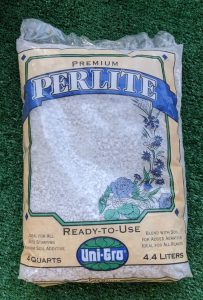
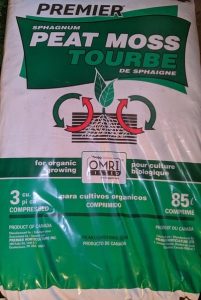
Buy Ready-made Carnivorous Plant Soil
You can also buy already made carnivorous plant soil. With this strategy, you ensure the medium is appropriate. However, it can be a lot more expensive. Etsy and Amazon are good options to buy carnivorous plant soil. Do a quick search for carnivorous plant soil and you will find many options. Just keep an eye on the reviews to verify the authenticity. A quart of carnivorous plant soil costs on $5-10 a quart.
This is an example of an affordable and effective carnivorous plant soil mix. It usually costs less than 10 dollars for a quart. Follow the link to confirm the price on Amazon.com.
Venus Flytrap Potting Basics
This section will guide you through the process of potting a Venus flytrap. First, start by gathering all the required materials: water, pot, plant, and soil. Also, tweezers and scissors can be useful tools.
Water
Venus flytraps can only be watered with nutrient-free mineral-free water. Use a pure source of water for your plant. Here are some options:
- Rainwater
- Distilled water
- Reverse osmosis water
You will need water to prepare the soil and to water the plant after potting. Never employ tap water or bottled water for Venus flytraps. The presence of minerals and other components can kill the plant. Also, when you buy distilled water or reverse osmosis water make sure the label indicates that the water is pure. Some brands add minerals for the flavor to distilled water. Even though it is technically distilled water, the presence of minerals can kill your plant.
Pot
Choose an appropriate container for your Venus flytrap. Some important considerations to choose a pot are the following:
- Pot Material
- Dimensions
- Drainage
If you would like the exact venus fly trap pot recommendations I use and a guide to select the best containers, check this article.
Pot Material: The best pot materials for Venus flytraps are plastic and glazed ceramic. Also, you can employ Styrofoam containers as suitable pots. These materials are the best candidates because they provide insulation, and they do not leak components to the ground. Glass and metal containers are acceptable materials. But, they do not provide adequate insulation for extreme summer or winter temperatures. Terracotta and clay pots are very common within the gardening community. However, these materials leak components to the ground, and therefore, they are not recommended.
Pot Dimensions: Venus flytraps grow better in individual containers. For best results choose a container that matches the size of the plant. The diameter dimensions of the container range from 2-6 inches depending on the size of the plant. The depth of the container is very important too. Venus flytraps thrive in tall containers (4-6 inches).
Drainage: A pot with drainage is as important as soil with good drainage. Choose containers with a drainage hole. It is possible to grow Venus flytraps in a container without drainage holes, but it is a big challenge. Beginners should always choose pots with drainage.
These pots are some good examples of suitable containers for Venus flytraps. Follow the links below to check their specs and their current price on Amazon.
- Nursery pots for single plants: https://amzn.to/3HhvEEx
- Net pots for single plants: https://amzn.to/2TMqgDJ
The Plant
Get your plant ready for potting it. If it is currently inside a dome or a small nursery pot, remove the plant from it. Use some distilled water to loosen up the soil. Then squeeze the edges of the containers and carefully start removing the plant from its current pot.
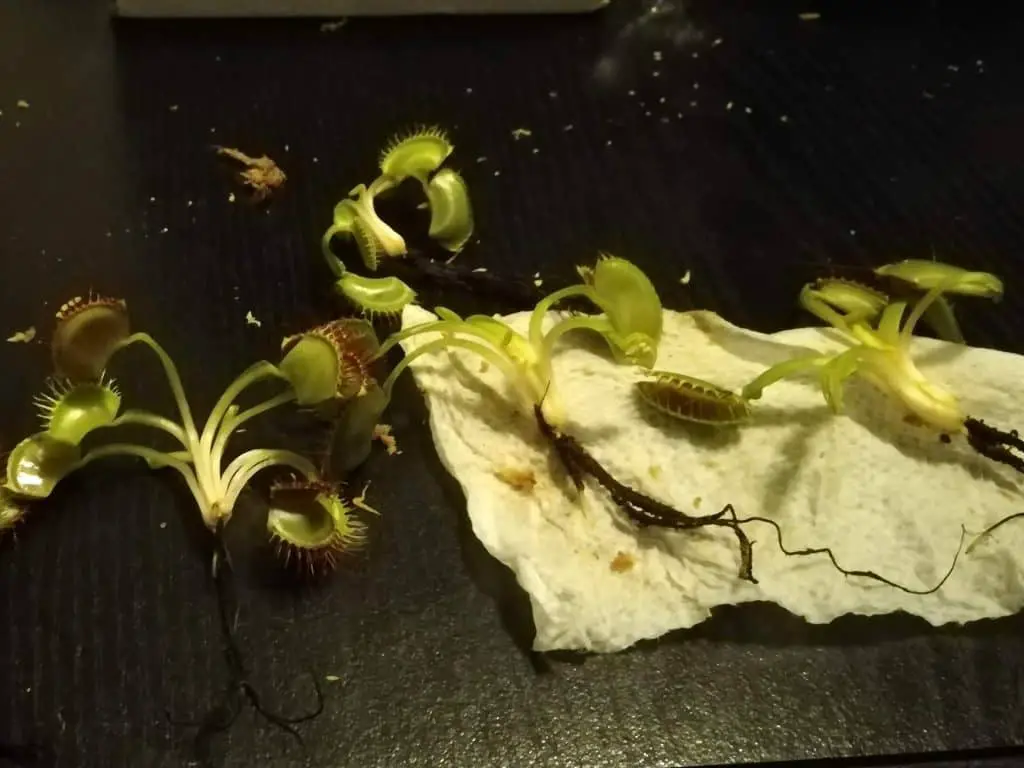
The leaves of a Venus flytrap can handle some stress. Treat your plant with care, but do not worry about touching the leaves. The rhizome or bulb of the plant is delicate delicate. the picture on the right shows some bare root Venus flytraps. the rhizome is the white section of the root.
Follow this link for a list of great shops to buy beautiful Venus fly traps: Shopping Guide.
How to Prepare the Soil for Venus Flytraps
Now that you have your plant ready to be potted, a suitable plant container, and pure water, it is time to prepare the soil. Follow these steps to get the soil ready for potting.
Choose the Soil Recipe
Gather the moss and perlite or sand. Then, decide on a suitable soil mix, like the ones described in the first section. Remember that choosing a ratio is not rocket science. So, do not over complicate it. For this example, I used peat moss and perlite. The ratio is 4 parts peat moss and 1 part perlite.
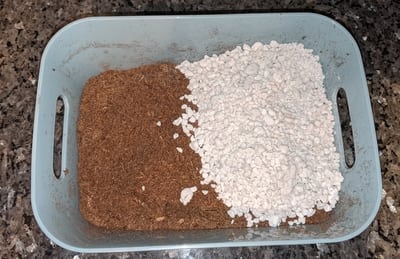
Mix the Soil and Add Water
Now that you have both ingredients. Go ahead and mix them thoroughly. Then, add water by parts. A lot of water will be absorbed by the moss right away. Be patient, and add more water until the whole medium is moist. The final product should look similar to these:

The soil for Venus flytraps should remain humid at all times. Once the ground starts drying up, it needs to be watered again. When you moisten the soil for potting your plant, make sure the medium is completely saturated with water. Your plant will prefer a very humid environment when adjusting to its new environment.
Venus Flytrap Potting Step By Step
This section will guide you step by step on how to pot a Venus flytrap:
1.- Grab your already mixed and moisten soil and place it in the pot.
2.- Use your fingers or a small shovel to set the ground in place, but do not over compress it. Also, make sure the top level of the soil is close to the edge of the pot.
3.- Employ a long and slim tool to make a deep and narrow opening in the soil, like the one below:
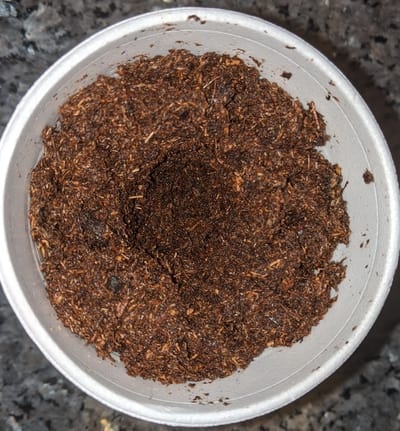
4.- Grab your plant from the top of the rhizome, holding all the leaves together
5.- Carefully introduce the roots of your plant inside the hole. Do your best to set the plant’s roots as vertical as possible.
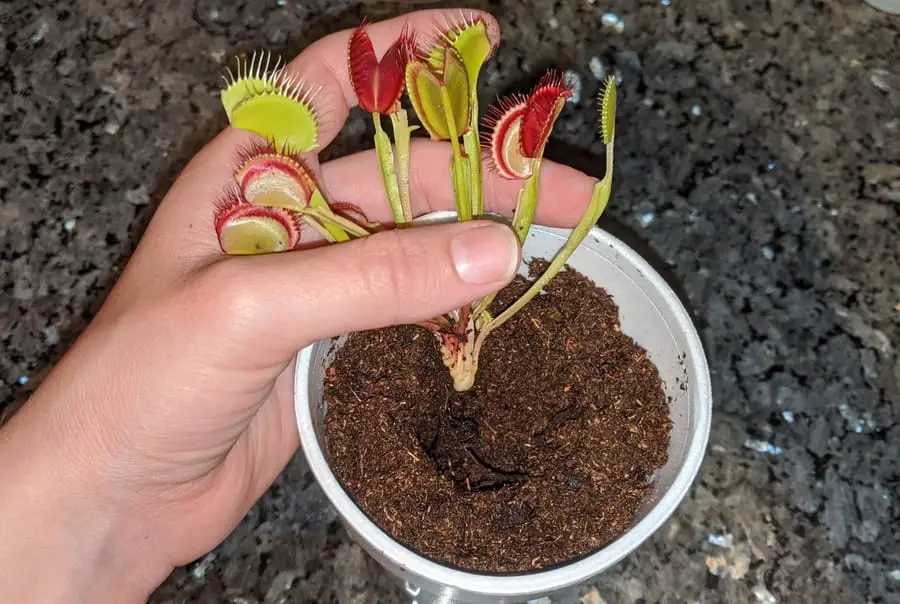
6.- Push the soil surrounding the hole towards the plant. When you set the plant in the soil, make sure the ground covers the rhizome area. The rhizome is very delicate and should not be exposed to sunlight.
7.- Add more soil surrounding the plant’s bulb to secure it in place.
8.- Water the plant from the top. The water pressure will help keep the ground in place.
Now, you are all set! Your plant is ready to start growing strong. However, due to the repotting, your plant might appear weak for a few weeks. Do not get too worried, but instead follow these considerations to ensure your Venus flytrap recovers completely:
- Keep the soil moist at all times. When you water the plant, only employ distilled, reverse osmosis, or rainwater.
- Do not feed the Venus flytrap for at least two weeks. Venus flytraps benefit from consuming an occasional bug. However, in this particular scenario, do not risk losing any leaves or causing strain for the plant.
- Avoid any fertilizer.
- Expose the plant to the appropriate lighting. If your plant is used to 12 hours of light, then continue to place it in its sunny spot. If instead, you just received this plant in the mail, slowly introduce it to sunlight. Do not make an abrupt change. But, ultimately, end up exposing the plant to at least 6 hours of sunlight (or artificial light).
- Avoid unwanted stress. Do not trigger the traps or move the plant too much. Leave it alone with enough light and water.
Final Potting Tips
Through the previous sections, you learned how to choose/make carnivorous plant soil and how to pot a Venus flytrap. Here are some final tips to supplement what you learned:
- When potting a Venus flytrap, avoid triggering the traps: The interior of the lobes of each trap has three trigger hairs. Touching those sensitive filaments activates the traps. The closing traps can’t hurt humans, but they drain the plant’s energy. Not only during potting but always avoid triggering the traps to save the plant’s energy.
- Gather all materials before starting the potting process: Setting up a Venus flytrap in a new home is exciting, but is also a challenge. Make sure you have the pot, water, and soil ready before you remove the Venus flytrap from its existing container.
- Employ tools to make the process easier: Some people like using their hands to mix the dirt and handle bare-root plants, but others prefer to use tools. Consider using a small shovel to mix the soil. Also, plastic tweezers can be useful for holding the Venus flytrap.
- Do not be scared about handling the plant: Venus flytraps are resilient plants. They prefer stress-free situations but can take the human touch. There is no reason to be concerned about touching the leaves of the roots.
- Water the soil appropriately to keep it healthy: Even the best soil can get infested with fungus or bacteria if it is overwatered. The Venus flytrap requires humid soil at all times. However, the ground shouldn’t be soaking wet. After potting the Venus flytrap, practice watering the plant. Make sure the humidity level is appropriate.
For more details and tips on the potting process, read this article: Venus flytrap potting and repotting guide.
When to Change the Soil of a Venus Flytrap
Carnivorous plant soil can last for a long time in an optimal state. Still, you must repot your plant in fresh soil every so often. The general recommendation is to repot in fresh soil once a year. Repotting at the end of dormancy or during early spring provides the best results.
After a year, soil tends to get compressed, it can start to become acidic, and the drainage won’t be optional. The yearly repotting does not have to be scheduled at the exact calendar year, but it is a recommendation. I have seen videos of people showing their five year Venus flytrap that has never been repotted. In many cases, those plants are doing great. However, the old soil is not promoting the plant’s growth.
Besides the yearly repotting to freshen up the growing medium, there are some occasions when you MUST repot your Venus flytrap. Here are the specifics:
Wrong water source: Employing the wrong water source can poison your plant. When Venus flytraps are water with tap water for long periods, the leaves start turning yellow, and the soil saturates with unwanted components. Repot a Venus flytrap if it exhibits mineral burns. Mineral burns are easy to identify: the presence of yellowing leaves.
Root rot: Even though Venus flytraps require a moist environment at all times, they are prone to root rot. Excessive humidity, together with the presence of bacteria or fungus, create root rot issues. Venus flytraps die if the rot eats up the whole bulb of the root. When a plant is suffering from root rot, you must repot with fresh soil and extract the rotting section of the root. I have a whole article that covers all the details. Remember, you must act quick: How to fix Venus Flytrap root rot.
Should I Replace the Soil Due to the Presence of Algae?
You do not need to replace the soil in a Venus flytrap due to algae. Venus flytraps can live healthy in the same container with algae. The only reason why most growers repot the plants due to algae is aesthetic. It doesn’t look good when the soil starts looking green, and the water plate exhibits green coloring. From a health perspective, there will be no harmful effects.
Here is an example of some perfectly healthy Venus flytraps that have algae growing in the soil. I clean up the water plate pretty often to give it a clean look, but after a few days, it starts getting green again.
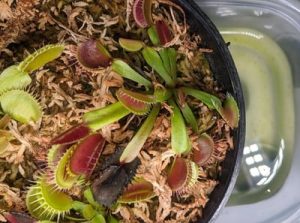
The main reason algae start growing in the soil is the high humidity index and poor drainage. The Venus flytrap above is planted in pure long-fibered sphagnum moss. The moss is excellent at retaining moisture, but it does not provide enough drainage. Since the pot is the right size for the plant, I won’t be repotting it any time soon. But, when I do, I will choose a potting medium with better drainage and aeration.
This article teaches you exactly how to eradicate all the Algae in your Venus flytrap.
Should You Add Fertilizers to Carnivorous Plant Soil?
Like I mentioned before, Venus flytraps live healthy lives without fertilizer. The general recommendation for all beginners is to skip any fertilizer. If you want to boost your Venus flytrap’s growth, focus on feeding bugs or spiders. However, it is a common misconception that all fertilizers kill Venus flytraps.
It is NOT recommended to add fertilizer to the soil. Still, you can employ foliar fertilizers. Foliar fertilizers are sprayed directly to the plant’s leaves. Then, the plant absorbs the added nutrient through the leaf tissue
Related Questions
What to Do if the Soil or the Venus Flytrap Smells?
Venus flytraps do not produce any smell and its soil should be odorless. The main causes of odor emanating from the soil are the following:
- Mold: Mold has a distinguishable smell, and it is not pleasant. Overwatering can lead to the presence of mold. The mold will only feed on dead tissue and shouldn’t harm your plant. However, the smell can be unpleasant.
- Foliage: Sometimes, odors in your plant are not coming from the plant or the soil. The foliage within the pot can emit smells, especially with carnivorous plants. Sometimes Venus flytraps capture a bug and attempt to digest it. In some cases, they digest it completely. In others, the leaf might die with the insect’s body inside. Then, the insect will stat decomposing slowly and might produce unwanted smells. To prevent odors, consider trimming your plant and removing the excessive foliage.
- Root rot: This last cause is the most problematic as root rot can kill Venus flytraps. When the rhizome of a Venus flytrap is being consumed by root rot, it emits unwanted odors. You can confirm the presence of root rot by inspecting the bulb of the plant. Mushy, dark, and stinky spots are clear signs of rotting.
Can I Use Succulent Soil for Venus Flytrap?
As a carnivorous plant grower, many people ask me questions about the Venus flytrap soil requirements. Some are curious if succulent soil is appropriate for Venus flytraps.
Venus flytraps can not be potted in succulent soil. The common ingredients for succulent soil are sand, perlite, and potting mix. The sand and perlite are common ingredients for carnivorous plant soil, but the standard potting mix is unsuitable.
Succulent soil contains minerals and fertilizers to provide nutrients to the plant. Venus fly traps won’t be able to process the nutrient present in succulent soil.
Is Cactus Soil Appropriate for Venus Flytrap?
Cactus soil and succulent soil are similar. However, each specific brand might offer a different composition. Cactus soil is unsuitable for Venus flytraps due to the plant’s intolerance to nutrients and fertilizers.
Recommended Products for Growing Carnivorous Plants
Finding the best pots, lights, and soil for carnivorous plants is difficult. I have grown carnivorous plants for over 5 years, and these are the products I use. The links will take you to Amazon to view the prices and full specs:
- Carnivorous Plant Soil
- Carnivorous plant soil: https://amzn.to/422yLZa
- Artificial Lighting
- Small plant light for 1-2 plants: https://amzn.to/3oQsmSj
- T8 LED light fixture for multiple plants (6500k Cool White): https://amzn.to/3uWoeh2
- Pots and Miscellaneus
- Nursery pots for single plants: https://amzn.to/3oL8YGq
- TDS meter to measure water quality: https://amzn.to/3g8VKLI
- Dried crickets to feed carnivorous plants: https://amzn.to/34QEnKv
